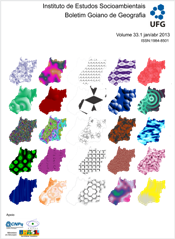SACRED TERRITORY: EXILE, DIASPORA AND KRENAK RECONQUEST IN RIO DOCE VALLEY (RESPLENDOR, MINAS GERAIS, BRAZIL) - DOI 10.5216/bgg.v33i1.23628
DOI:
https://doi.org/10.5216/bgg.v33i1.23628Abstract
The indigenous Brazilian group – Krenak – botocudo remnants, survived several government attacks which aimwas to exterminate or civilize them. The first State actions were fundamental in the process of editing CartaRegia (1808), by establishing Military Divisions in Rio Doce focusing that territory demographic occupationand the elimination of botocudo people, considered an obstacle to the region economic growth. This policy,starting in Brazilian Colonial time and intensified during the Segundo Reinado (mainly in the XIX Century), did notachieve the intended success and Rio Doce Valley received a meaningful demographic occupation, after Vitoria-Minas Railway implantation, in 1910 decade. Having this background as a starting point, this article debates theKrenak territory construction, in Resplendor (Minas Gerais State district), in Rio Doce Valley, considering exiles,diasporas and land reconquest, from 1958 until 1997. It will address SPI (former Governmental Office dealingwith indigenous issues: Indian’s Protection Service) and Funai actions (today’s Governmental Office: Indians’National Foundation) in the process of expropriating those indigenous people. It will also address the sameprocess from the Krenak people’s perspective, considering the sacred links established with natural elementsand their influence in the construction of a territory sacred to the Krenak.Downloads
Downloads
Published
How to Cite
Issue
Section
License
Authors will not receive any payment for publishing their work in Boletim Goiano de Geografia. Therefore, they must grant all rights to the journal. However, they are entirely and exclusively responsible for the published contents, and editors are free to make corrections or adjustments to texts in conformity with publication guidelines.







